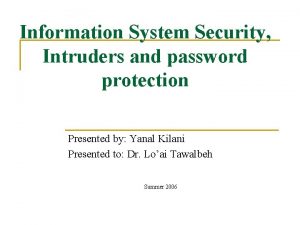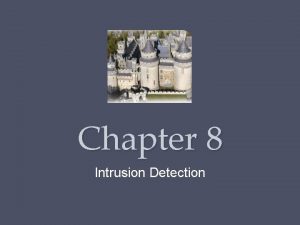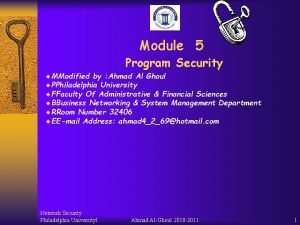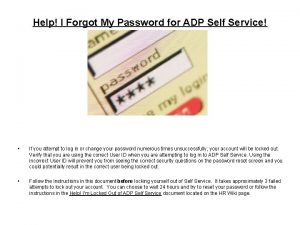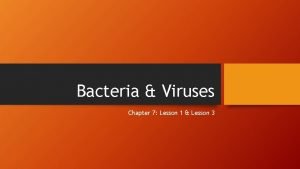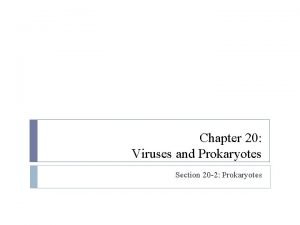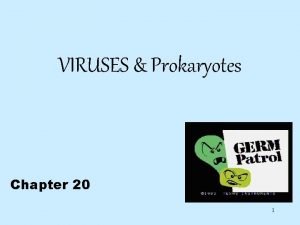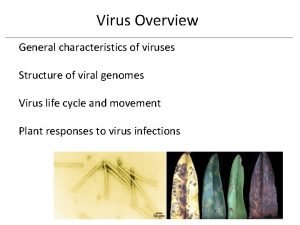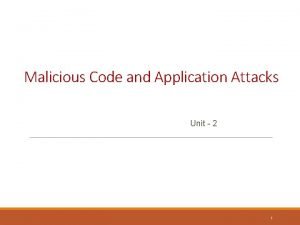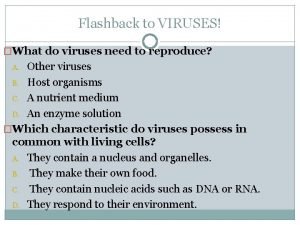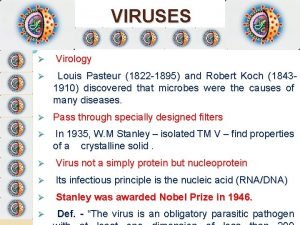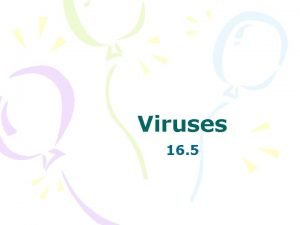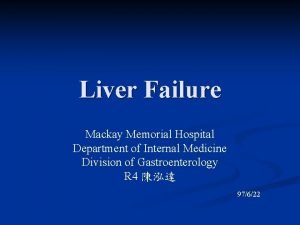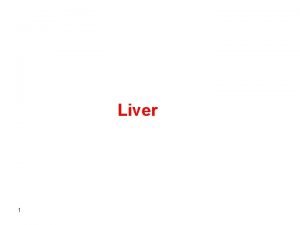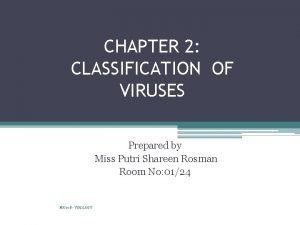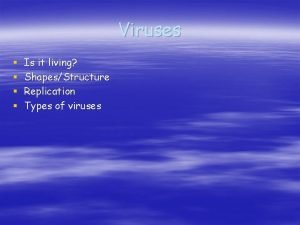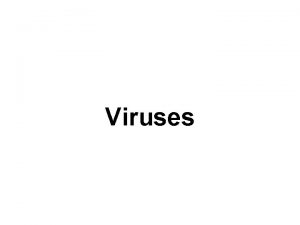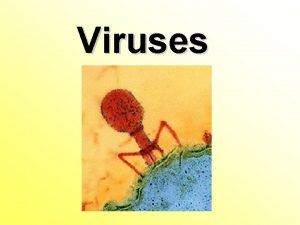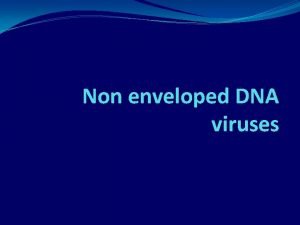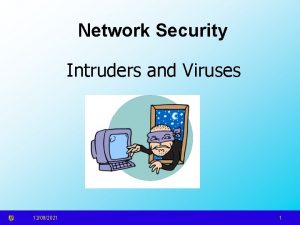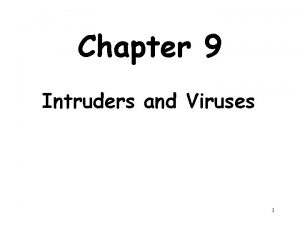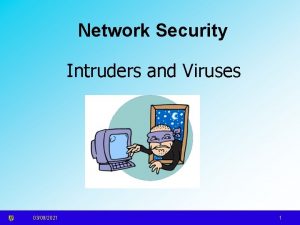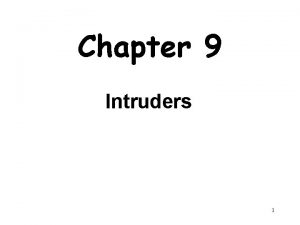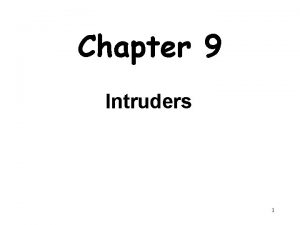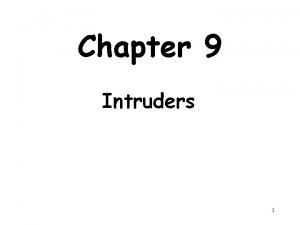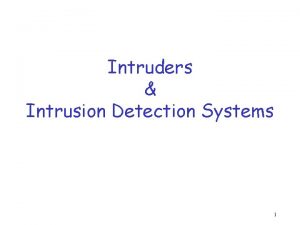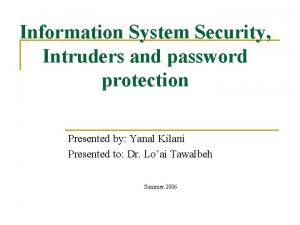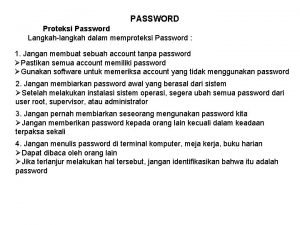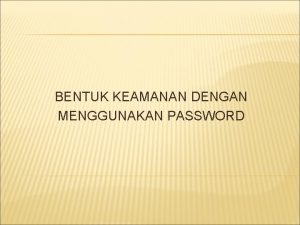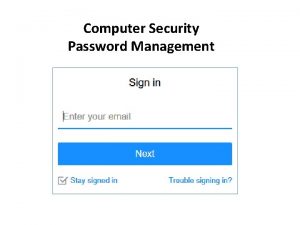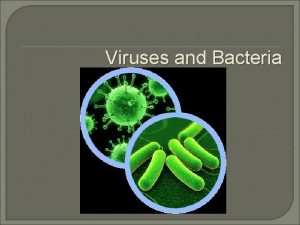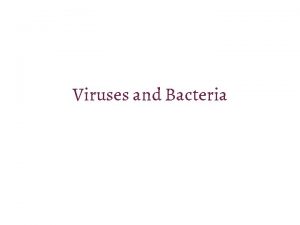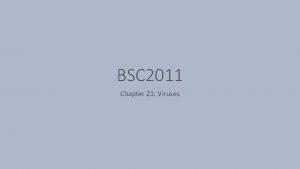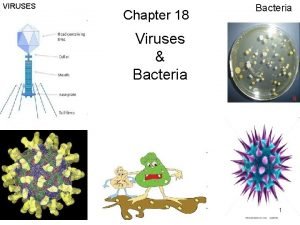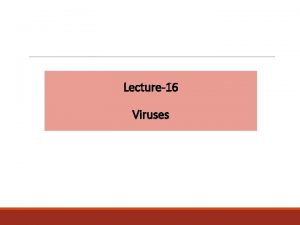Network Security Intruders and Viruses 09032021 1 Password













































- Slides: 45

Network Security Intruders and Viruses 09/03/2021 1

Password Management Part Two - Cracking 09/03/2021 2

Intrusion Techniques Objective: Gain access to a system Frequent Goal: Acquiring a user password Most systems have a file that maps a password to each user Password file protection: one-way encryption access control 09/03/2021 3

Password Learning Techniques g u e s s a t t a c k 1. Try default passwords used with standard accounts shipped with the system 2. Exhaustive try of all short passwords 3. Try words in system’s dictionary or list of likely passwords (hacker bulletin boards) 4. Collect information about users (full names, names of spouses and children, pictures and books in their office, related hobbies) 5. Try users’ phone numbers, social security numbers, room numbers 6. Try all legitimate license plate numbers 7. Use a trojan horse 8. Tap the line between a remote user and the system 09/03/2021 4

Password Protection Unix password scheme threats: Gain access through a guest account and run a password cracker Obtain a copy of the password file and run a password cracker Goal: Run a password cracker Rely on people choosing easily guessable passwords! 09/03/2021 5

Password Cracking 09/03/2021 6

Password Cracking Unix Password File (/etc/passwd): daemon: x: 1: 1: : /: bin: x: 2: 2: : /usr/bin: sys: x: 3: 3: : /: nobody: x: 60001: Nobody: /: eric: Gm. TFg 0 Aav. FA 0 U: 1001: 10: Eric Schwartz: /export/home/eric: /bin/ksh temp: k. RWeg. G 5 i. TZP 5 o: 1002: 10: IP Administration: /export/home/ipadmin: /bin/ksh jfr: kyz. KROryh. FDE 2: 506: : /home/jfr: /bin/csh Results of the password cracker: $ john passwd Loaded 3 passwords with 3 different salts (Standard DES [24/32 4 K]) temp (temp) jenny (eric) solaris 1 (jfr) 09/03/2021 7

Password Crackers 09/03/2021 8

Virus and Related Threats 09/03/2021 9

Malicious Programs Two categories: Those that need a host program – fragments of programs - parasitic Those that are independent – self contained Some replicate – used as a differentiator 09/03/2021 10

Taxonomy of Malicious Programs 09/03/2021 11

Malicious Programs Logic Bombs: logic embedded in a program that checks for a set of conditions to arise and executes some function resulting in unauthorized actions Trapdoors: secret undocumented entry point into a program, used to grant access without normal methods of access authentication (e. g. , War Games) 09/03/2021 12

Trojan Horse 09/03/2021 13

Malicious Programs Trojan Horse: secret undocumented routine embedded within a useful program, execution of the program results in execution of the routine Common motivation is data destruction 09/03/2021 14

Malicious Programs Zombie: a program that secretly takes over an Internet attached computer and then uses it to launch an untraceable attack Very common in Distributed Denial-Of. Service attacks 09/03/2021 15

Viruses 09/03/2021 16

Viruses A virus is a submicroscopic parasitic particle that infects cells in biological organisms. Viruses are non-living particles that can only replicate when an organism reproduces the viral RNA or DNA. Viruses are considered non-living by the majority of virologists www. virology. net 09/03/2021 17

Viruses: code embedded within a program that causes a copy of itself to be inserted in other programs and performs some unwanted function Infects other programs Code is the DNA of the virus 09/03/2021 18

Worms 09/03/2021 19

Worms: program that can replicate itself and send copies to computers across the network and performs some unwanted function Uses network connections to spread from system to system 09/03/2021 20

Bacteria: consume resources by replicating themselves Do not explicitly damage any files Sole purpose is to replicate themselves Reproduce exponentially Eventually taking up all processors, memory or disk space 09/03/2021 21

Nature of Viruses Four stages of virus lifetime Dormant phase: virus idle Propagation phase: cloning of virus Triggering phase: virus activation Execution phase: unwanted function performed 09/03/2021 22

Virus Structure program V: = {goto main: 1234567; special marker determines if infected subroutine infect-executable : = {loop: file: = get-random-executable-file; if (first-line-of-file = 1234567) then goto loop else prepend V to file; } subroutine do–damage : = {whatever damage is to be done} subroutine trigger-pulled : = {return true if some condition holds} main: main-program : = {infect-executable; if trigger-pulled then do-damage; goto next; } next: transfer control to the original program } 09/03/2021 23

Avoiding Detection Infected version of program is longer than the corresponding uninfected one Solution: compress the executable file so infected and uninfected versions are identical in length 09/03/2021 24

Avoiding Detection 09/03/2021 25

Compression Program infected 09/03/2021 uninfected 26

Types of Viruses Parasitic Virus: attached to executables, replicates when program is executed Memory-resident virus: part of a resident system program, affects every program executed Boot sector virus: infects a master boot record and spreads when system is booted from infected disk 09/03/2021 27

Types of Viruses Stealth virus: virus designed to hide itself from detection by antivirus software (compression, interception of I/O logic) Polymorphic virus: mutates with every infection making detection by “signature” impossible (mutation engine) Macro virus: infects Microsoft Word docs; 2/3’s of all viruses 09/03/2021 28

Macro Viruses 2/3 s of all viruses Mainly Microsoft products – platform independent Affect documents not executables Easily spread by e-mail Autoexecuting macro is the culprit 09/03/2021 29

Worms Uses network connections to spread from system to system Similar to a virus – has same phases: dormant, propagation, trigger and execution Morris Worm – most famous Recent: OSX. Leap. A, Kama Sutra, Code Red 09/03/2021 30

Buffer Overflow Program attempts to write more data into buffer than that buffer can hold… …Starts overwriting area of stack memory Can be used maliciously to cause a program to execute code of attackers choose Overwrites stack point 09/03/2021 31

Mechanics of stack-based buffer overflow Stack is like a pile of plates When a function is called, the return address is pushed on the stack return In a function, local variables function are written on the stack Memory is written on stack local stack char username[4] memory reserved 4 bytes of space on stack 0 X 0692 0 X 0691 0 X 0123 0 X 0690 � 0 X 0689 s 0 X 0688 y 0 X 0687 s 0 X 0686 0 X 0685 0 X 0684 09/03/2021 32

Mechanics of stack-based buffer overflow When function copies too much on the stack. . . the return pointer is overwritten Execution path of function changed when function ends Local stack memory has malicious code 0 X 0692 0 X 0691 return function local stack memory 0 X 0689 0 X 0123 0 X 0690 X 0 X 0689 X 0 X 0688 X 0 X 0687 X 0 X 0686 0 X 0685 0 X 0684 09/03/2021 33

Antivirus Approaches Detection – determine that it has occurred and locate the virus Identification – identify the specific virus Removal – remove all traces and restore the program to its original state 09/03/2021 34

Generations of Antivirus Software First: simple scanners (record of program lengths) Second: heuristic scanners (integrity checking with checksums) Third: activity traps (memory resident, detect infected actions) Fourth: full-featured protection (suite of antivirus techniques, access control capability) 09/03/2021 35

Advanced Techniques Generic Decryption Digital Immune System Behavior-Blocking Software 09/03/2021 36

Generic Decryption Easily detects even most complex polymorphic virus No damage to the personal computer Contains following elements: CPU emulator – software based virtual computer Virus signature scanner – scans target code for known signatures Emulation control module – control execution of target code 09/03/2021 37

Digital Immune System Pioneered by IBM Response to rate of virus propagation Integrated mail systems - Outlook Mobile program systems – Active. X, Java Expands the use of program emulation Depends on a central virus analysis machines 09/03/2021 38

Digital Immune System 09/03/2021 39

Behavior-Blocking Software Monitors program behavior in real-time for malicious actions – part of OS Look for well defined requests to the OS: modifications to files, disk formats, mods to scripts or macros, changes in config settings, open network connections, etc. IPS – Intrusion Prevention Systems 09/03/2021 40

Malicious Code Protection Types of Products Scanners - identify known malicious code - search for signature strings Integrity Checkers – determine if code has been altered or changed – checksum based Vulnerability Monitors - prevent modification or access to particularly sensitive parts of the system – user defined Behavior Blockers - list of rules that a legitimate program must follow – sandbox concept 09/03/2021 41

Important URLs http: //www. cert. org/ Originally DARPA’s computer emergency response team. An essential security site http: //www. research. ibm. com/antivirus/ IBM’s site on virus information. Very good papers – a little outdated http: //www. afsa. org/fsj/sept 00/Denning. cfm. Hacktivism: An Emerging Threat to Diplomacy, another Denning term along with Information Warfare http: //csrc. nist. gov/virus/Computer Security Resources Center – Virus information and alerts 09/03/2021 42

Important URLs http: //www. ciac. org/ciac/ Computer Incident Advisory Capability -another bookmark-able site to visit regularly http: //csrc. nist. gov/publications/nistpubs/800 -42/NISTSP 800 -42. pdf Guideline on Network Security Testing – covers password cracking http: //www. openwall. com/john/ Very good password cracker, “John the Ripper” http: //csrc. nist. gov/publications/nistpubs/800 -36/NISTSP 800 -36. pdf Guide to Selecting Information Security Products http: //www. xensource. com/ Xen Source - Hottest Area In Virtualization 09/03/2021 43

… enough! 09/03/2021 44

. . . coming to the end! Take Home Final Exam – On Website Due Next Class Return Papers Any Problems, Please Email Or Call Good Luck 09/03/2021 45
 Intruders in cryptography and network security
Intruders in cryptography and network security Unlike lytic viruses lysogenic viruses do not
Unlike lytic viruses lysogenic viruses do not Youtube . com / watch v = roxnvcaezjs
Youtube . com / watch v = roxnvcaezjs 09032021
09032021 Intruders in system security
Intruders in system security Classes of intruders
Classes of intruders Intruders use virus signatures fabricate
Intruders use virus signatures fabricate Wireless security in cryptography and network security
Wireless security in cryptography and network security Private securit
Private securit Osi security architecture model with neat diagram
Osi security architecture model with neat diagram Guide to network security
Guide to network security Electronic mail security in network security
Electronic mail security in network security Security guide to network security fundamentals
Security guide to network security fundamentals Security guide to network security fundamentals
Security guide to network security fundamentals Adp security change password
Adp security change password Section 19-3 diseases caused by bacteria and viruses
Section 19-3 diseases caused by bacteria and viruses Chapter 21 viruses and bacteria
Chapter 21 viruses and bacteria Nonliving particle that replicates inside a living cell
Nonliving particle that replicates inside a living cell What are viruses lesson 3 answer key
What are viruses lesson 3 answer key Chapter 20 viruses and prokaryotes
Chapter 20 viruses and prokaryotes Study guide chapter 18 section 1 bacteria
Study guide chapter 18 section 1 bacteria Section 1 studying viruses and prokaryotes
Section 1 studying viruses and prokaryotes Why are viruses considered nonliving?
Why are viruses considered nonliving? Which of the following is plant virus
Which of the following is plant virus General characteristics of viruses
General characteristics of viruses Viruses
Viruses Lysogenic viruses do not
Lysogenic viruses do not Cultivation of viruses
Cultivation of viruses Egg inoculation diagram
Egg inoculation diagram Blood borne viruses
Blood borne viruses Are viruses alive yes or no
Are viruses alive yes or no Importance of viruses
Importance of viruses Why are viruses considered nonliving
Why are viruses considered nonliving General characters of viruses
General characters of viruses Helical virus
Helical virus Hepatotropic viruses
Hepatotropic viruses Hepatotropic viruses
Hepatotropic viruses Hepatotropic viruses
Hepatotropic viruses Milad haddad
Milad haddad Nomenclature of viruses
Nomenclature of viruses Replication of viruses
Replication of viruses How do viruses differ from living things
How do viruses differ from living things Importance of viruses
Importance of viruses What kingdom do viruses belong to
What kingdom do viruses belong to Best viruses
Best viruses Best viruses
Best viruses




